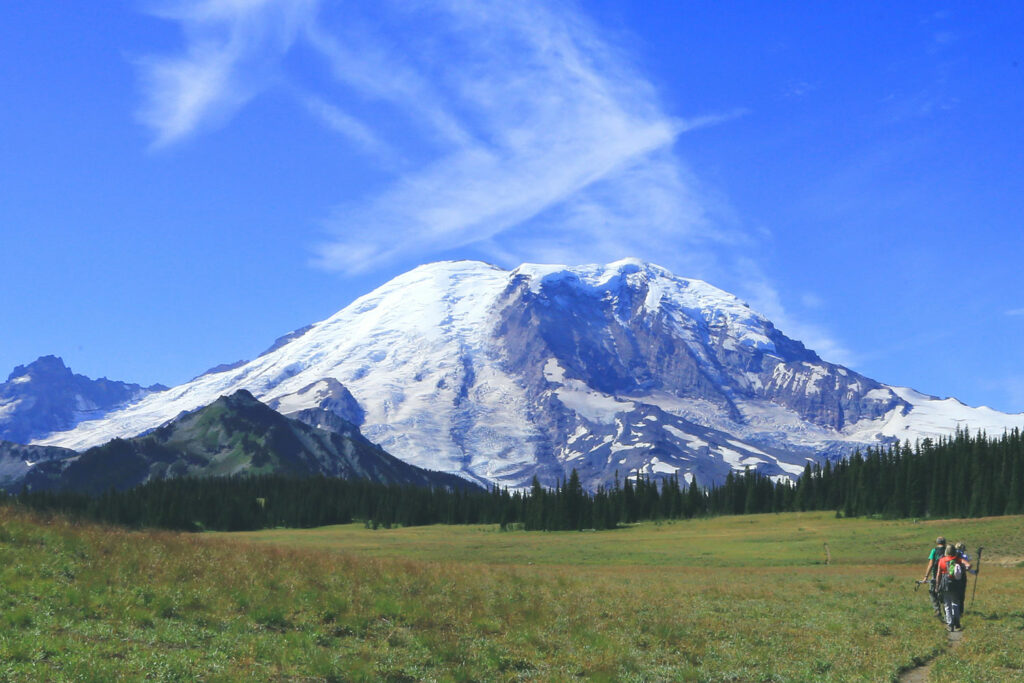More than 97 percent of Mount Rainier National Park is designated as wilderness. The wild nature of this environment offers wonderful opportunities but also presents some challenges. It is recommended that hikers review the following on the park service website: https://www.nps.gov/mora/planyourvisit/safety.htm.
Above all else hiking in such mountainous terrain requires a full measure of common sense. Every hiker and hiking party should exercise caution and practice the following guidelines.

Know Your Limits
Hikers must know their limits as well as those of every member of their party including health status, physical condition, stamina limitation, and degree of experience and training. The difficulty rankings provided by guidebooks may simply not apply to you or all members of your party. Difficulty rankings are relative; what’s easy for some may be very difficult for others. For example, some trails while seemingly of a fairly gentle constant grade may be constructed with literally hundreds of steps, or risers, (i.e. Mazama Ridge) and therefore be quite difficult for hikers who have knee or hip issues.
Be Prepared
The wildflower hikes presented on this site are considered “day hikes” and the published guidebooks used for reference purposes are day hiking guidebooks. Nevertheless a day hiker should ask themselves the question “what if I had to stay out overnight?”
What should a day hiking pack include? Much is made of the ten essentials so here they are: topographic map, compass, extra clothing, extra food, flashlight, first-aid kit, matches, fire starter (could be a candle), pocket knife, and sunglasses (as well as sunscreen). A couple thoughts on this list and a few additions. A compass is only as good as the proficiency of its use; hikers must be able to use the compass in conjunction with the topo map for proper orienteering (basic land navigation skills are important and easy to obtain). Is a GPS unit a fool proof substitute? Consider that it requires batteries and satellite reception. The knowledge obtained in basic land navigation for compass use is valuable in learning and using GPS.
No one wants a heavy day pack and it need not be. But some hikes, even though day hikes, are in remote areas of the park (i.e. Grand Park, Spray Park, Summerland) and help is likely a long ways away. You may not see a ranger with a radio all day. You may want to gear up some; for example that extra clothing should probably include some polar fleece, gloves and especially a water repellant hooded jacket even if it’s one of the light weight ones that stuff in a bag. Without adding hardly an ounce a couple Mylar space blankets would be welcome to retain body heat if that overnight stay became a reality or if one had to hunker down in bad weather.
There was a time when the old fogies who used ski poles to steady their gait got a chuckle. Now trekking poles have practically become one of the essentials for many. The benefits are obvious with improved balance, steadiness in crossing streams and snow fields, etc. They also have multiple purposes such as a make shift tent pole, a monopod to help steady that difficult camera shot, etc. Plus, if you had an encounter with a wild animal they might come in handy.
Check Conditions:
Before setting out current conditions should be checked to assure the best possible experience and minimize surprises. Here are some resources that are especially helpful. For specific information one of the wilderness information centers can be contacted and a ranger or volunteer will have the latest reports from the field.
- Weather Forecast: http://www.atmos.washington.edu/data/rainier_report.html
- Trail Conditions: https://www.nps.gov/mora/planyourvisit/trails-and-backcountry-camp-conditions.htm
- Ranger Stations: Go to https://www.nps.gov/mora/planyourvisit/basicinfo.htm for seasonal information, phone numbers, etc. The following are usually staffed by rangers who know the current conditions (numbers subject to change and may be only operational seasonally):
- Longmire Wilderness Information Center, 360-569-6650
- White River Wilderness Information Center, 360-569-6670
- Paradise Wilderness Information Center, 360-569-6641
- Carbon River Ranger Station, 360-829-9639
- Wildflower Blooming Status: https://www.nps.gov/mora/planyourvisit/wildflower-status.htm
Be Flexible
You know the old saying “the best-laid plans often go awry” which certainly can be the case in planning a hike. Checking current conditions and responding accordingly can alleviate some of the disappointment but it’s important to be flexible, have a backup plan, and even be prepared to “call it for another day.” An example would be arriving at the park entrance or at a trailhead and find that the parking lot is full or the trail is closed. It helps to always get an early start!
Hikes for the viewing (and photographing) wildflowers are not really destination oriented hikes but should be approached leisurely exercising your best powers of observation – to notice and to pay close attention to what you’re seeing. It’s the journey not the destination that’s important. The routes of the wildflower hikes on this site are divided into three or more sections, or legs. The legs vary by elevation range and the changing nature of the flora within each range. The maps have thumbnail photos suggesting what you might find but that is merely a sampling of what’s there. Take time to explore what’s along the trail in each leg. If you don’t complete all the legs that’s okay, redo the hike another day. On the other hand if you go right to the higher legs you may want to slow down on the return to see what you missed in the lower leg(s).
A word about hiking alone
A hiking partner is considered the 11th essential! Wildflower enthusiasts should try to find companions who share their interest. If you hike in groups, i.e. the Wednesday Hiking Club, expect a totally different experience. If alone, however, it is important to stay on heavy used trails where other hikers are around and hopefully a ranger assigned to that area. Unless specifically trained in survival skills individuals should avoid being alone in the backcountry and remote areas of the park.
